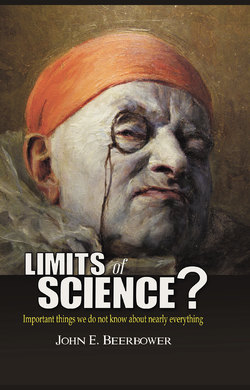Читать книгу Limits of Science? - John E. Beerbower - Страница 9
На сайте Литреса книга снята с продажи.
Deductive theories
ОглавлениеIt is commonly accepted that the most powerful and versatile of theories are deductive in structure.7 They contain a set of assumptions or premises (or axioms) followed by a set of rules for derivation or logical manipulation (sometimes called rules of transformation), so that one can draw conclusions of the form if A, then B, but often in far more complex structures with many variables. Such deductive theories can allow a variety of more remote identification (or prediction) of the consequences of specified starting conditions. However, nothing “new” is introduced—the subsequent implications are all contained in the initial axioms or assumptions, given the rules governing the manipulation of the axioms and the derivation of additional propositions. Deductive theories of this type generally lend themselves to formalization, specifically often to mathematical representation. Indeed, such theories can be viewed, and could have started life, as purely logical constructs. In fact, a good deductive theory will necessarily be a good logical construct. The question that arises is whether or how a deductive system bears any relationship with the external, real world.
Of interest here are theories that tie to or incorporate real, observable data or events—theories about the world in which we live. Such theories must contain what are called “contingent propositions”—statements about the world that are subject to verification or observation or, in other words, statements that can be “true” or “false”. See Richard Bevan Braithwaite, Scientific Explanation (Cambridge University Press, 1968), p.24. Thus, a theory would include contingent propositions, and an observer could attempt to ascertain whether those contingent propositions are true in the circumstances at hand. If so, then one could presumably make predictions (deductive inferences) that also included contingent propositions. Such inferences would be logically necessary within the theory (or deductive system). Such predictions could also be “tested” against real world data or used (relied upon) in real world applications.
In all events, it is crucial to be able to recognize when terms used in a theory merely appear to reference actual things (or are carelessly assumed to reference actual things) and when the theories contain real contingent propositions. A formal deductive system can be expressed in symbols. The symbols could be given names that are used in normal conversation to refer to physical objects.8 However, to tie the deductive system to the physical world, one needs also to introduce into the system logical propositions utilizing the “things” to which the names refer and that contain some factual (non-circular and not purely definitional) relationships that are subject to empirical testing—in other words, assertions that have some real content concerning the physical world.
There are terms that have meaning only in the context of the theory or the logical structure. An illustration set out by philosopher Gilbert Ryle is from the vocabulary of games. The word “trump” has no meaning out of the context of bridge, and one cannot explain its meaning without some explanation of the rules of that game. Dilemmas (1954), p.33. Another matter that deserves attention, to avoid misunderstandings, is the use in theories of terms that have an ordinary usage but technical meanings in the context of the theory, such as the “mass” or the “temperature” of an object. The technical meanings are defined by the theory. As Ryle explained, “technical terms … are theory-laden, laden, that is, not just with theoretical luggage of some sort or other but with the luggage of…theory. Their meanings change with changes in the theory. Knowing their meanings requires some grasp of the theory.” Id., p.90.
At some level, all words are “theory-laden,” that is based upon or reflecting models of the physical world that people use to comprehend their environment. Obviously, it is important at least to identify and communicate the particular models involved in statements made, in order to avoid misunderstandings and miscommunications.
Modern scientific theories regularly make use of terms or concepts that are not subject to direct sensory observation. A frequently cited example is the “electron.” It is an assumed or hypothesized “object” defined by several characteristics, including a negative electrical charge. The catalogue of characteristics defines the term functionally and enables it to be utilized in theories of atomic and molecular structures. Obviously, the related theories have been very successful and powerful. But, does an electron actually “exist”? See, e.g., Brian Greene, The Elegant Universe (2005), pp.108–16. This example will be discussed further in a later chapter.
